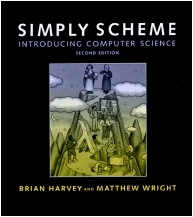
Matthew Wright
University of California, Berkeley
MIT Press web page for Simply Scheme
|
|
Brian
Harvey Matthew Wright University of California, Berkeley MIT Press web page for Simply Scheme |
By now you're very familiar with the idea of implementing a function by composing other functions. In effect we are breaking down a large problem into smaller parts. The idea of recursion--as usual, it sounds simpler than it actually is--is that one of the smaller parts can be the same function we are trying to implement.
At clothes stores they have arrangements with three mirrors hinged together. If you keep the side mirrors pointing outward, and you're standing in the right position, what you see is just three separate images of yourself, one face-on and two with profile views. But if you turn the mirrors in toward each other, all of a sudden you see what looks like infinitely many images of yourself. That's because each mirror reflects a scene that includes an image of the mirror itself. This self-reference gives rise to the multiple images.
Recursion is the idea of self-reference applied to computer programs. Here's an example:
"I'm thinking of a number between 1 and 20."
(Her number is between 1 and 20. I'll guess the halfway point.) "10."
"Too low."
(Hmm, her number is between 11 and 20. I'll guess the halfway point.) "15."
"Too high."
(That means her number is between 11 and 14. I'll guess the halfway point.) "12."
"Got it!"
We can write a procedure to do this:
(define (game low high)
(let ((guess (average low high)))
(cond ((too-low? guess) (game (+ guess 1) high))
((too-high? guess) (game low (- guess 1)))
(else '(I win!)))))
This isn't a complete program because we haven't written
too-low? and too-high?. But it illustrates the
idea of a problem that contains a version of itself as a subproblem: We're
asked to find a secret number within a given range. We make a guess, and if
it's not the answer, we use that guess to create another problem in which
the same secret number is known to be within a smaller range. The
self-reference of the problem description is expressed in Scheme by a
procedure that invokes itself as a subprocedure.
Actually, this isn't the first time we've seen self-reference in this book. We defined "expression" in Chapter 3 self-referentially: An expression is either atomic or composed of smaller expressions.
The idea of self-reference also comes up in some paradoxes: Is the sentence "This sentence is false" true or false? (If it's true, then it must also be false, since it says so; if it's false, then it must also be true, since that's the opposite of what it says.) This idea also appears in the self-referential shapes called fractals that are used to produce realistic-looking waves, clouds, mountains, and coastlines in computer-generated graphics.